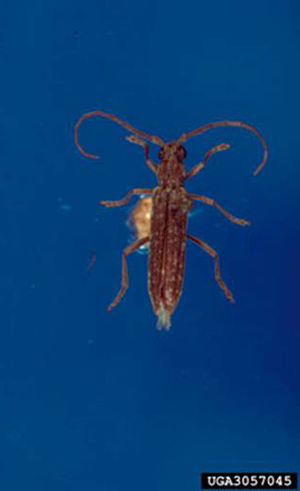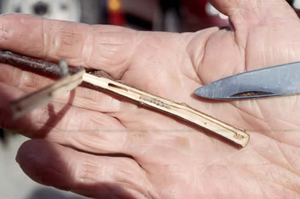DACF Home → Bureaus & Programs → Maine Forest Service → Forest Health & Monitoring → Forest Pest Index → Oak Twig Pruner
OAK TWIG PRUNER
Anelaphus parallelus (Newman)

Oak Twig Pruner Adult
Photo: James Solomon, USDA Forest Service, Bugwood.org
Symptoms and Damage
Dry, browned oak branches, 1/4 inch to 2 inches in diameter, hanging in the trees or littering the ground is usually indicative of the oak twig pruner.

Photo: Maine Forest Service; Forest Health and Monitoring Slide Collection
The adult is a brownish, elongate beetle, 3/8 to 3/4 inch in length. The larva is white and legless and resides within oak twigs causing the damage. The larvae feed in the branches of many hardwoods but principal damage is on oak. Infested branches are weakened by the larva so that they break off and fall to the ground. Damage is never severe enough to kill or severely damage trees. On ornamental oaks, however, the hanging dead twigs may be unsightly and the shape of the tree may be altered.
Hosts
Oak, hickory, elm, walnut, and a number of fruit trees. A related species of twig pruner, A. villosus, also occurs in Maine and prunes twigs and branches from an even wider variety of hardwood hosts.
Life History
This species takes two years to mature. The adults of the oak twig pruner fly about the time the oak leaves are beginning to form, and deposit eggs near the tips of twigs. The young larvae mine down the stems, increasing in size, until late summer. They spend the first winter within the twig usually near a node or thickened area. They resume feeding the second season and soon begin their pruning cuts beneath the bark. Larvae cut around the branch except for the thin bark so that the branches break with the wind and fall to the ground. The larvae remain in the fallen branches for up to several months, pupating in the fall. Adults emerge the following spring. Damage is most noticeable in alternate years.
Control
Chemical controls have not been developed for this insect as control in woodland situations is not normally necessary or feasible. The severity of damage on ornamental trees can be reduced, however, by gathering all fallen branches in late summer or autumn and burning them to kill the larvae/pupae. This must be thoroughly done and extended some distance in the surrounding area to be effective.
MAINE DEPARTMENT OF AGRICULTURE, CONSERVATION AND FORESTRY
Maine Forest Service - Forest Health and Monitoring Division
April 2000